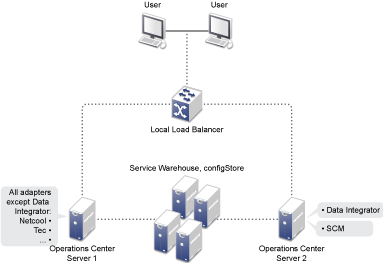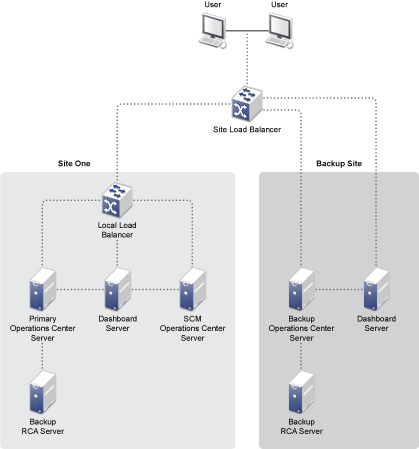6.6 Scaling Operations Center
Because every customer’s implementation is different, ongoing user load and performance monitoring might be required to determine when and if the Operations Center configuration should be modified. A Operations Center sizing study can be performed to help determine Java memory settings and/or architectural recommendations.
6.6.1 Example 1: Run SCM on a Separate Server
As an example, lets look at a configuration that runs various application and network management integration adapters (such as Netcool, TEC, and so on), Data Integrator, and SCM, which implements service models on an enterprise level. Instead of one server bearing the load, the following could be implemented to scale the environment:
-
Server 1 runs adapters for all application and network management integrations.
-
Server 2 runs Data Integrator and is the designated server for all SCM functionality.
Note that the SCM job is disabled and isCordinator() is implemented so that related scripts are run only on this server.
For more information, see Section 6.4.6, Additional Considerations and Configurations.
-
A load balancer shares user load between both servers:

6.6.2 Example 2: Use Remote Containers to Off-Load Adapter Overhead, and Migrate the Dashboard and SCM to Separate Servers
For an additional example, we’ll take an even larger environment and see some additional ways Operations Center might be further scaled. In this example, the dashboard can be run from a separate server and remote containers can be used to take overhead of the adapters.
-
The Primary server handles SLM.
-
The Operations Center dashboard server runs the dashboard.
-
The SCM Server runs Data Integrator and is the designated server for all SCM functionality.
-
An additional server is added to off-load the overhead of adapters (implemented using Remote Container Adapters (RCAs)) while the adapters appear to be running on the primary Operations Center server and the Backup Operations Center server.
-
While a local load balancer is used to fail over between Primary and Backup servers, a site load balancer is used for site to site:
